CNA803 Semester 1 2019: Strategies for Reducing Aggression in Youth
VerifiedAdded on 2023/04/06
|11
|3182
|80
Literature Review
AI Summary
This literature review investigates strategies for reducing aggression in children and youth, addressing a significant mental health concern. It explores social-cognitive behavioral interventions, highlighting the importance of social problem-solving skills and conflict resolution. The review also examines behavioral parent training (BPT) programs like the Coping Power (CP) program, which focuses on improving parental courtesy and communication. Furthermore, it discusses youth/child-focused programs, emphasizing anger control training and arousal management techniques. The research draws from various studies and meta-analyses to assess the effectiveness of these strategies in minimizing aggressive behaviors and promoting positive youth development. Desklib provides access to this literature review and many other student contributed assignments.
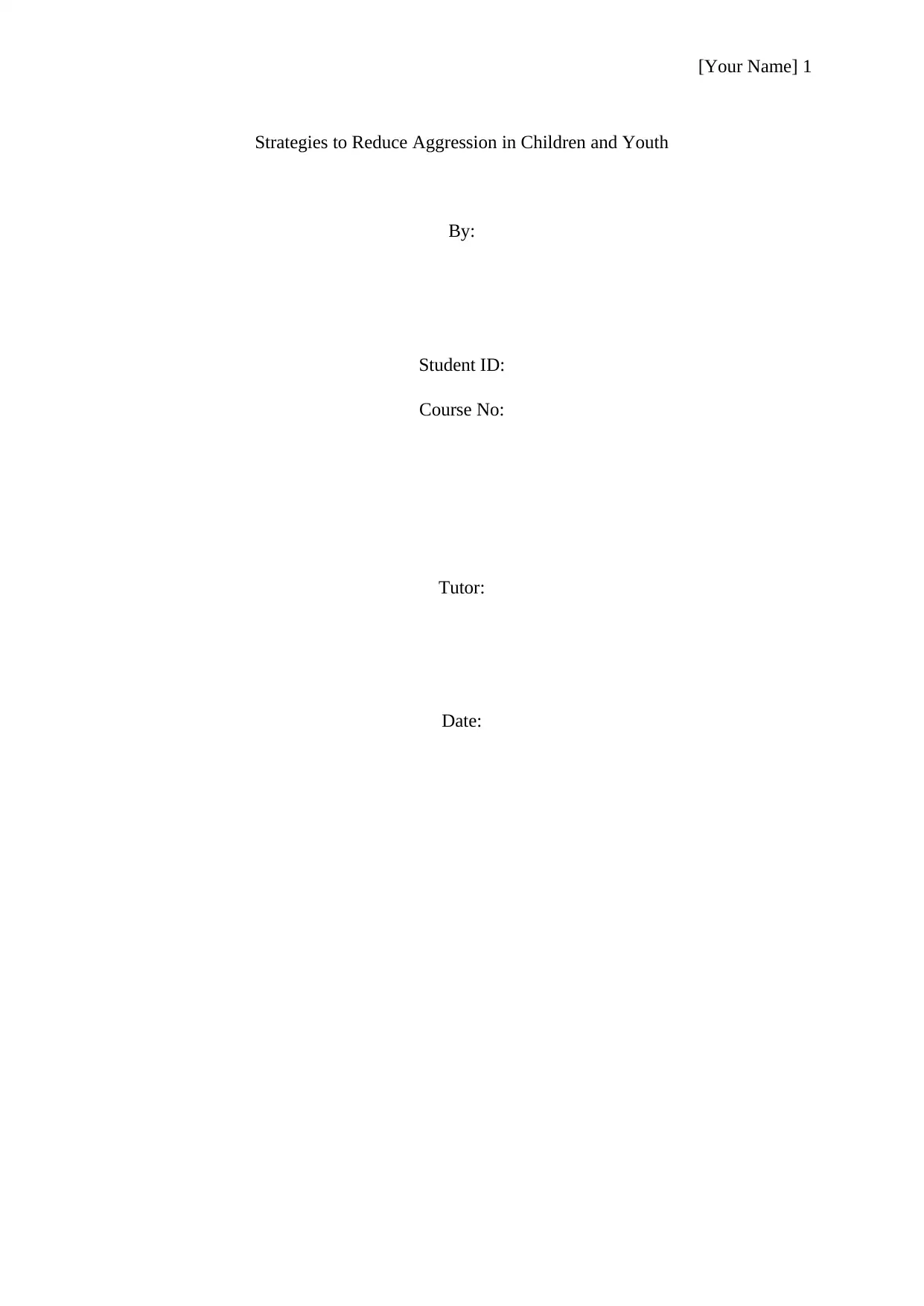
[Your Name] 1
Strategies to Reduce Aggression in Children and Youth
By:
Student ID:
Course No:
Tutor:
Date:
Strategies to Reduce Aggression in Children and Youth
By:
Student ID:
Course No:
Tutor:
Date:
Paraphrase This Document
Need a fresh take? Get an instant paraphrase of this document with our AI Paraphraser
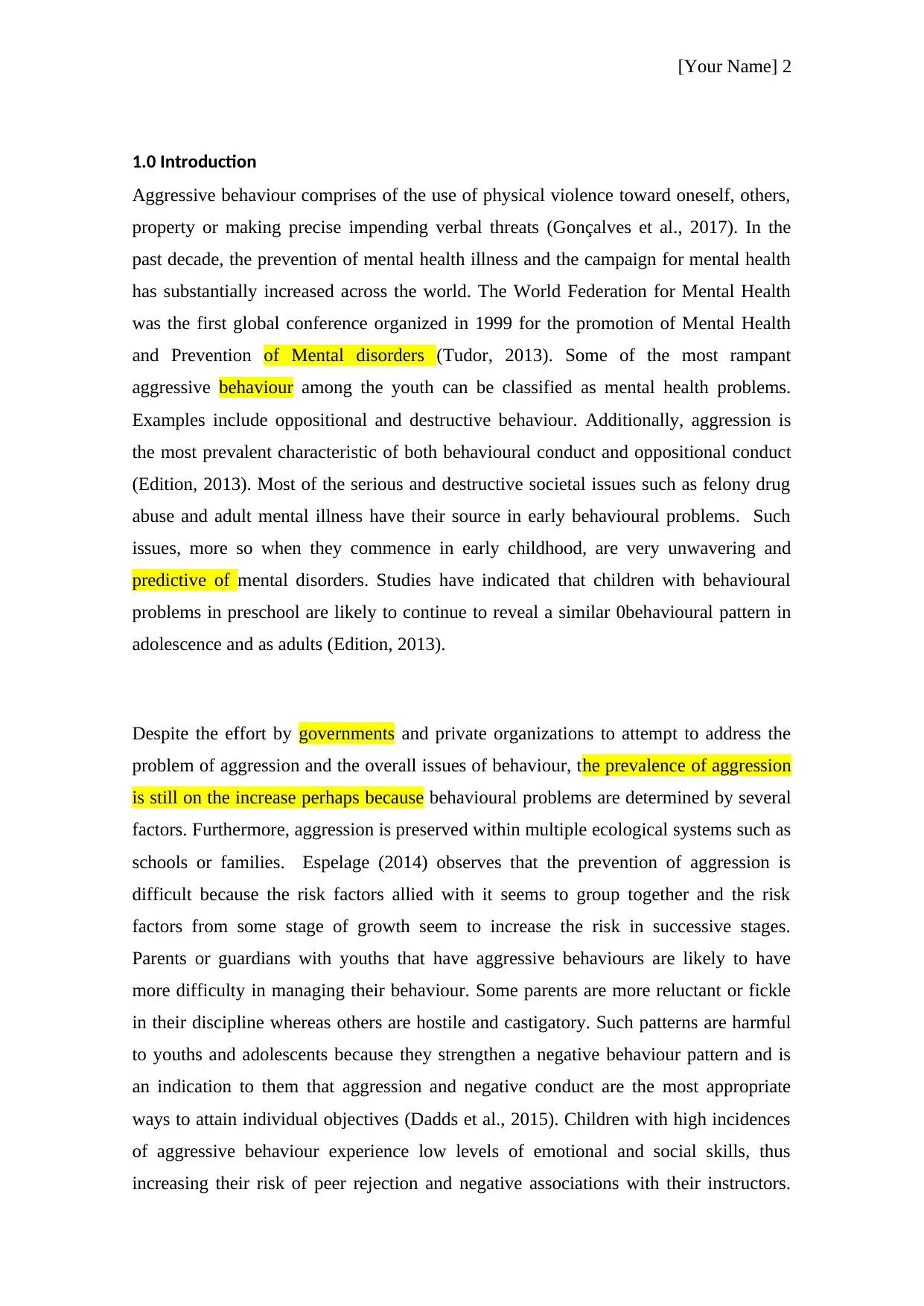
[Your Name] 2
1.0 Introduction
Aggressive behaviour comprises of the use of physical violence toward oneself, others,
property or making precise impending verbal threats (Gonçalves et al., 2017). In the
past decade, the prevention of mental health illness and the campaign for mental health
has substantially increased across the world. The World Federation for Mental Health
was the first global conference organized in 1999 for the promotion of Mental Health
and Prevention of Mental disorders (Tudor, 2013). Some of the most rampant
aggressive behaviour among the youth can be classified as mental health problems.
Examples include oppositional and destructive behaviour. Additionally, aggression is
the most prevalent characteristic of both behavioural conduct and oppositional conduct
(Edition, 2013). Most of the serious and destructive societal issues such as felony drug
abuse and adult mental illness have their source in early behavioural problems. Such
issues, more so when they commence in early childhood, are very unwavering and
predictive of mental disorders. Studies have indicated that children with behavioural
problems in preschool are likely to continue to reveal a similar 0behavioural pattern in
adolescence and as adults (Edition, 2013).
Despite the effort by governments and private organizations to attempt to address the
problem of aggression and the overall issues of behaviour, the prevalence of aggression
is still on the increase perhaps because behavioural problems are determined by several
factors. Furthermore, aggression is preserved within multiple ecological systems such as
schools or families. Espelage (2014) observes that the prevention of aggression is
difficult because the risk factors allied with it seems to group together and the risk
factors from some stage of growth seem to increase the risk in successive stages.
Parents or guardians with youths that have aggressive behaviours are likely to have
more difficulty in managing their behaviour. Some parents are more reluctant or fickle
in their discipline whereas others are hostile and castigatory. Such patterns are harmful
to youths and adolescents because they strengthen a negative behaviour pattern and is
an indication to them that aggression and negative conduct are the most appropriate
ways to attain individual objectives (Dadds et al., 2015). Children with high incidences
of aggressive behaviour experience low levels of emotional and social skills, thus
increasing their risk of peer rejection and negative associations with their instructors.
1.0 Introduction
Aggressive behaviour comprises of the use of physical violence toward oneself, others,
property or making precise impending verbal threats (Gonçalves et al., 2017). In the
past decade, the prevention of mental health illness and the campaign for mental health
has substantially increased across the world. The World Federation for Mental Health
was the first global conference organized in 1999 for the promotion of Mental Health
and Prevention of Mental disorders (Tudor, 2013). Some of the most rampant
aggressive behaviour among the youth can be classified as mental health problems.
Examples include oppositional and destructive behaviour. Additionally, aggression is
the most prevalent characteristic of both behavioural conduct and oppositional conduct
(Edition, 2013). Most of the serious and destructive societal issues such as felony drug
abuse and adult mental illness have their source in early behavioural problems. Such
issues, more so when they commence in early childhood, are very unwavering and
predictive of mental disorders. Studies have indicated that children with behavioural
problems in preschool are likely to continue to reveal a similar 0behavioural pattern in
adolescence and as adults (Edition, 2013).
Despite the effort by governments and private organizations to attempt to address the
problem of aggression and the overall issues of behaviour, the prevalence of aggression
is still on the increase perhaps because behavioural problems are determined by several
factors. Furthermore, aggression is preserved within multiple ecological systems such as
schools or families. Espelage (2014) observes that the prevention of aggression is
difficult because the risk factors allied with it seems to group together and the risk
factors from some stage of growth seem to increase the risk in successive stages.
Parents or guardians with youths that have aggressive behaviours are likely to have
more difficulty in managing their behaviour. Some parents are more reluctant or fickle
in their discipline whereas others are hostile and castigatory. Such patterns are harmful
to youths and adolescents because they strengthen a negative behaviour pattern and is
an indication to them that aggression and negative conduct are the most appropriate
ways to attain individual objectives (Dadds et al., 2015). Children with high incidences
of aggressive behaviour experience low levels of emotional and social skills, thus
increasing their risk of peer rejection and negative associations with their instructors.
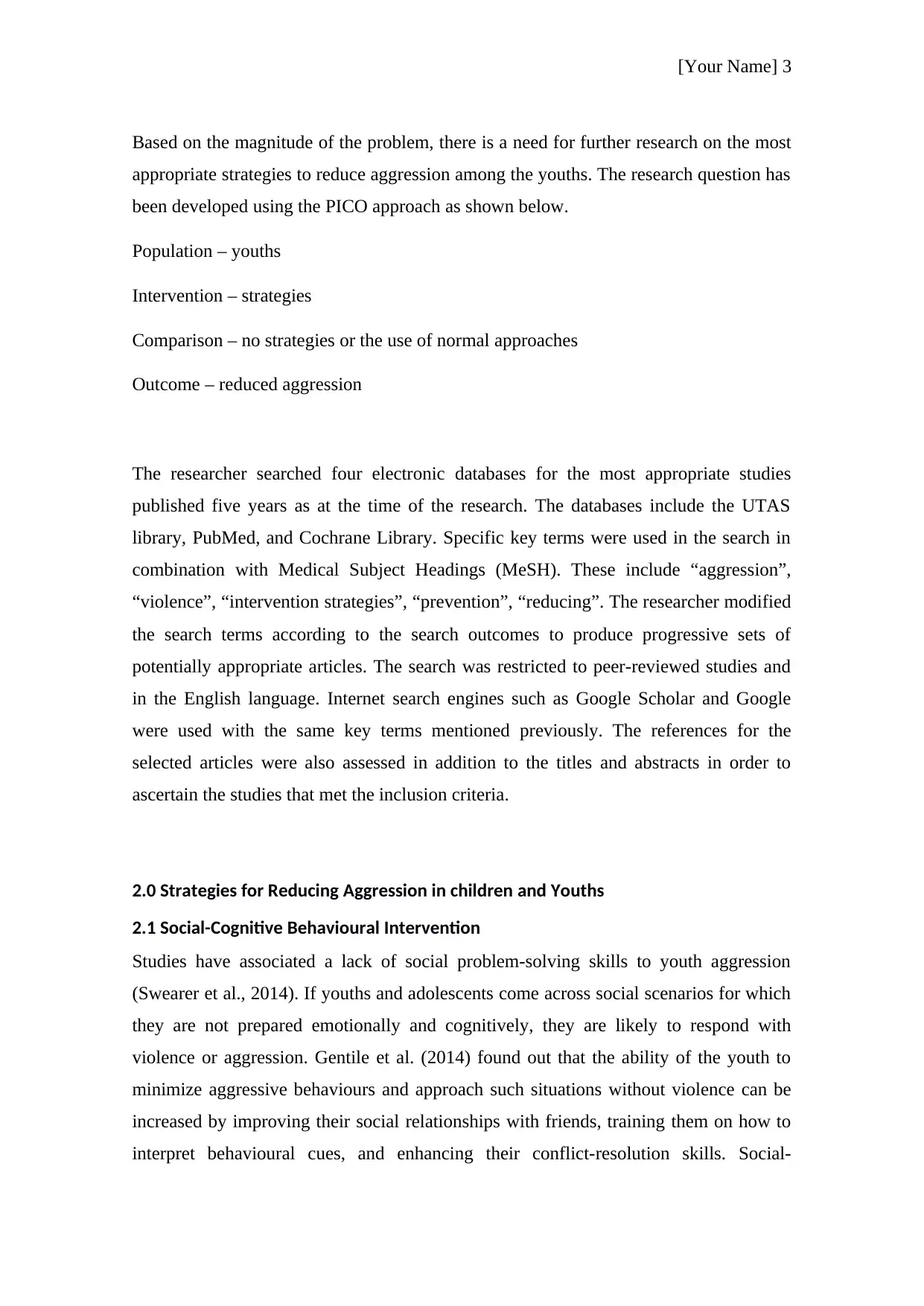
[Your Name] 3
Based on the magnitude of the problem, there is a need for further research on the most
appropriate strategies to reduce aggression among the youths. The research question has
been developed using the PICO approach as shown below.
Population – youths
Intervention – strategies
Comparison – no strategies or the use of normal approaches
Outcome – reduced aggression
The researcher searched four electronic databases for the most appropriate studies
published five years as at the time of the research. The databases include the UTAS
library, PubMed, and Cochrane Library. Specific key terms were used in the search in
combination with Medical Subject Headings (MeSH). These include “aggression”,
“violence”, “intervention strategies”, “prevention”, “reducing”. The researcher modified
the search terms according to the search outcomes to produce progressive sets of
potentially appropriate articles. The search was restricted to peer-reviewed studies and
in the English language. Internet search engines such as Google Scholar and Google
were used with the same key terms mentioned previously. The references for the
selected articles were also assessed in addition to the titles and abstracts in order to
ascertain the studies that met the inclusion criteria.
2.0 Strategies for Reducing Aggression in children and Youths
2.1 Social-Cognitive Behavioural Intervention
Studies have associated a lack of social problem-solving skills to youth aggression
(Swearer et al., 2014). If youths and adolescents come across social scenarios for which
they are not prepared emotionally and cognitively, they are likely to respond with
violence or aggression. Gentile et al. (2014) found out that the ability of the youth to
minimize aggressive behaviours and approach such situations without violence can be
increased by improving their social relationships with friends, training them on how to
interpret behavioural cues, and enhancing their conflict-resolution skills. Social-
Based on the magnitude of the problem, there is a need for further research on the most
appropriate strategies to reduce aggression among the youths. The research question has
been developed using the PICO approach as shown below.
Population – youths
Intervention – strategies
Comparison – no strategies or the use of normal approaches
Outcome – reduced aggression
The researcher searched four electronic databases for the most appropriate studies
published five years as at the time of the research. The databases include the UTAS
library, PubMed, and Cochrane Library. Specific key terms were used in the search in
combination with Medical Subject Headings (MeSH). These include “aggression”,
“violence”, “intervention strategies”, “prevention”, “reducing”. The researcher modified
the search terms according to the search outcomes to produce progressive sets of
potentially appropriate articles. The search was restricted to peer-reviewed studies and
in the English language. Internet search engines such as Google Scholar and Google
were used with the same key terms mentioned previously. The references for the
selected articles were also assessed in addition to the titles and abstracts in order to
ascertain the studies that met the inclusion criteria.
2.0 Strategies for Reducing Aggression in children and Youths
2.1 Social-Cognitive Behavioural Intervention
Studies have associated a lack of social problem-solving skills to youth aggression
(Swearer et al., 2014). If youths and adolescents come across social scenarios for which
they are not prepared emotionally and cognitively, they are likely to respond with
violence or aggression. Gentile et al. (2014) found out that the ability of the youth to
minimize aggressive behaviours and approach such situations without violence can be
increased by improving their social relationships with friends, training them on how to
interpret behavioural cues, and enhancing their conflict-resolution skills. Social-
⊘ This is a preview!⊘
Do you want full access?
Subscribe today to unlock all pages.

Trusted by 1+ million students worldwide
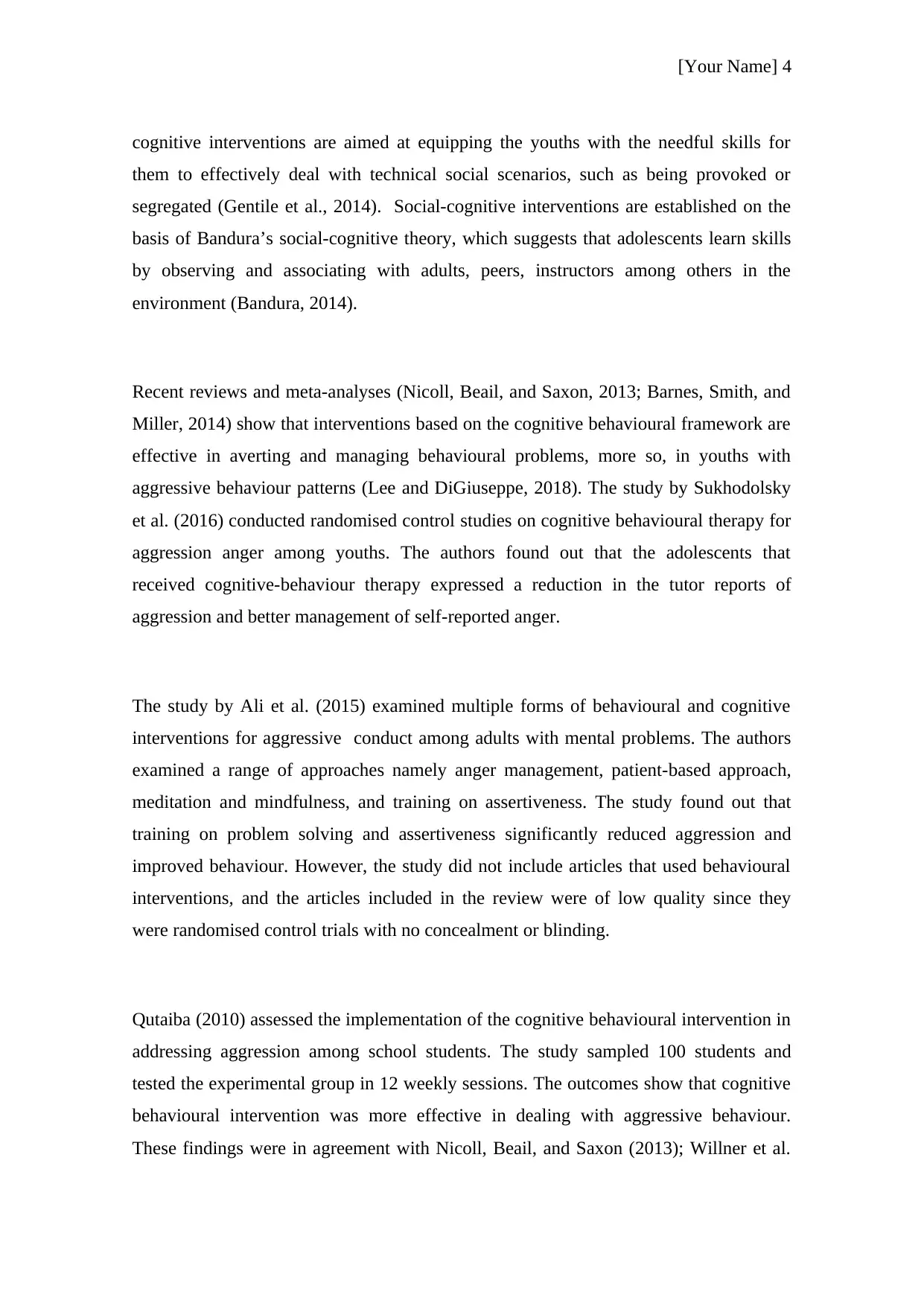
[Your Name] 4
cognitive interventions are aimed at equipping the youths with the needful skills for
them to effectively deal with technical social scenarios, such as being provoked or
segregated (Gentile et al., 2014). Social-cognitive interventions are established on the
basis of Bandura’s social-cognitive theory, which suggests that adolescents learn skills
by observing and associating with adults, peers, instructors among others in the
environment (Bandura, 2014).
Recent reviews and meta-analyses (Nicoll, Beail, and Saxon, 2013; Barnes, Smith, and
Miller, 2014) show that interventions based on the cognitive behavioural framework are
effective in averting and managing behavioural problems, more so, in youths with
aggressive behaviour patterns (Lee and DiGiuseppe, 2018). The study by Sukhodolsky
et al. (2016) conducted randomised control studies on cognitive behavioural therapy for
aggression anger among youths. The authors found out that the adolescents that
received cognitive-behaviour therapy expressed a reduction in the tutor reports of
aggression and better management of self-reported anger.
The study by Ali et al. (2015) examined multiple forms of behavioural and cognitive
interventions for aggressive conduct among adults with mental problems. The authors
examined a range of approaches namely anger management, patient-based approach,
meditation and mindfulness, and training on assertiveness. The study found out that
training on problem solving and assertiveness significantly reduced aggression and
improved behaviour. However, the study did not include articles that used behavioural
interventions, and the articles included in the review were of low quality since they
were randomised control trials with no concealment or blinding.
Qutaiba (2010) assessed the implementation of the cognitive behavioural intervention in
addressing aggression among school students. The study sampled 100 students and
tested the experimental group in 12 weekly sessions. The outcomes show that cognitive
behavioural intervention was more effective in dealing with aggressive behaviour.
These findings were in agreement with Nicoll, Beail, and Saxon (2013); Willner et al.
cognitive interventions are aimed at equipping the youths with the needful skills for
them to effectively deal with technical social scenarios, such as being provoked or
segregated (Gentile et al., 2014). Social-cognitive interventions are established on the
basis of Bandura’s social-cognitive theory, which suggests that adolescents learn skills
by observing and associating with adults, peers, instructors among others in the
environment (Bandura, 2014).
Recent reviews and meta-analyses (Nicoll, Beail, and Saxon, 2013; Barnes, Smith, and
Miller, 2014) show that interventions based on the cognitive behavioural framework are
effective in averting and managing behavioural problems, more so, in youths with
aggressive behaviour patterns (Lee and DiGiuseppe, 2018). The study by Sukhodolsky
et al. (2016) conducted randomised control studies on cognitive behavioural therapy for
aggression anger among youths. The authors found out that the adolescents that
received cognitive-behaviour therapy expressed a reduction in the tutor reports of
aggression and better management of self-reported anger.
The study by Ali et al. (2015) examined multiple forms of behavioural and cognitive
interventions for aggressive conduct among adults with mental problems. The authors
examined a range of approaches namely anger management, patient-based approach,
meditation and mindfulness, and training on assertiveness. The study found out that
training on problem solving and assertiveness significantly reduced aggression and
improved behaviour. However, the study did not include articles that used behavioural
interventions, and the articles included in the review were of low quality since they
were randomised control trials with no concealment or blinding.
Qutaiba (2010) assessed the implementation of the cognitive behavioural intervention in
addressing aggression among school students. The study sampled 100 students and
tested the experimental group in 12 weekly sessions. The outcomes show that cognitive
behavioural intervention was more effective in dealing with aggressive behaviour.
These findings were in agreement with Nicoll, Beail, and Saxon (2013); Willner et al.
Paraphrase This Document
Need a fresh take? Get an instant paraphrase of this document with our AI Paraphraser
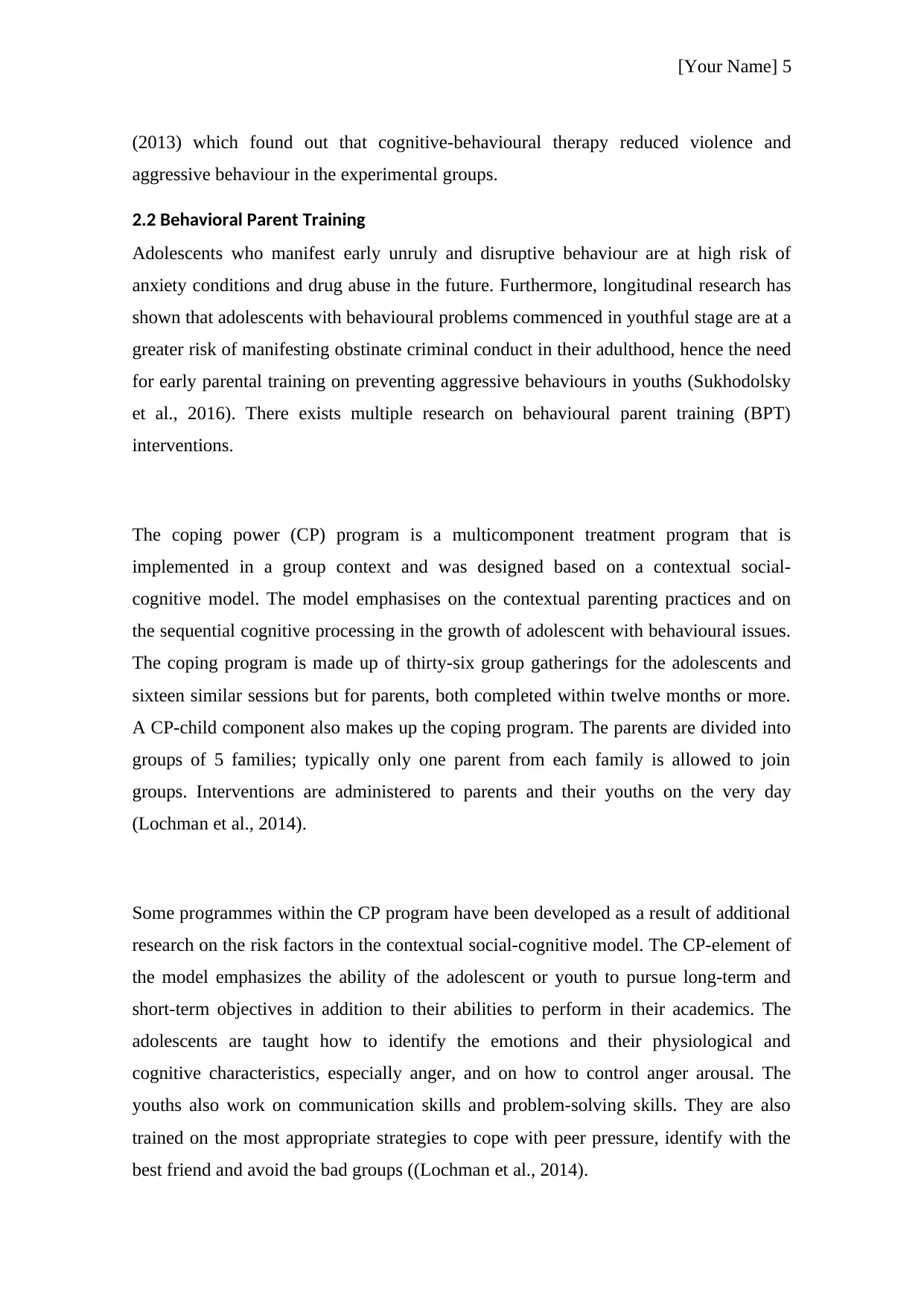
[Your Name] 5
(2013) which found out that cognitive-behavioural therapy reduced violence and
aggressive behaviour in the experimental groups.
2.2 Behavioral Parent Training
Adolescents who manifest early unruly and disruptive behaviour are at high risk of
anxiety conditions and drug abuse in the future. Furthermore, longitudinal research has
shown that adolescents with behavioural problems commenced in youthful stage are at a
greater risk of manifesting obstinate criminal conduct in their adulthood, hence the need
for early parental training on preventing aggressive behaviours in youths (Sukhodolsky
et al., 2016). There exists multiple research on behavioural parent training (BPT)
interventions.
The coping power (CP) program is a multicomponent treatment program that is
implemented in a group context and was designed based on a contextual social-
cognitive model. The model emphasises on the contextual parenting practices and on
the sequential cognitive processing in the growth of adolescent with behavioural issues.
The coping program is made up of thirty-six group gatherings for the adolescents and
sixteen similar sessions but for parents, both completed within twelve months or more.
A CP-child component also makes up the coping program. The parents are divided into
groups of 5 families; typically only one parent from each family is allowed to join
groups. Interventions are administered to parents and their youths on the very day
(Lochman et al., 2014).
Some programmes within the CP program have been developed as a result of additional
research on the risk factors in the contextual social-cognitive model. The CP-element of
the model emphasizes the ability of the adolescent or youth to pursue long-term and
short-term objectives in addition to their abilities to perform in their academics. The
adolescents are taught how to identify the emotions and their physiological and
cognitive characteristics, especially anger, and on how to control anger arousal. The
youths also work on communication skills and problem-solving skills. They are also
trained on the most appropriate strategies to cope with peer pressure, identify with the
best friend and avoid the bad groups ((Lochman et al., 2014).
(2013) which found out that cognitive-behavioural therapy reduced violence and
aggressive behaviour in the experimental groups.
2.2 Behavioral Parent Training
Adolescents who manifest early unruly and disruptive behaviour are at high risk of
anxiety conditions and drug abuse in the future. Furthermore, longitudinal research has
shown that adolescents with behavioural problems commenced in youthful stage are at a
greater risk of manifesting obstinate criminal conduct in their adulthood, hence the need
for early parental training on preventing aggressive behaviours in youths (Sukhodolsky
et al., 2016). There exists multiple research on behavioural parent training (BPT)
interventions.
The coping power (CP) program is a multicomponent treatment program that is
implemented in a group context and was designed based on a contextual social-
cognitive model. The model emphasises on the contextual parenting practices and on
the sequential cognitive processing in the growth of adolescent with behavioural issues.
The coping program is made up of thirty-six group gatherings for the adolescents and
sixteen similar sessions but for parents, both completed within twelve months or more.
A CP-child component also makes up the coping program. The parents are divided into
groups of 5 families; typically only one parent from each family is allowed to join
groups. Interventions are administered to parents and their youths on the very day
(Lochman et al., 2014).
Some programmes within the CP program have been developed as a result of additional
research on the risk factors in the contextual social-cognitive model. The CP-element of
the model emphasizes the ability of the adolescent or youth to pursue long-term and
short-term objectives in addition to their abilities to perform in their academics. The
adolescents are taught how to identify the emotions and their physiological and
cognitive characteristics, especially anger, and on how to control anger arousal. The
youths also work on communication skills and problem-solving skills. They are also
trained on the most appropriate strategies to cope with peer pressure, identify with the
best friend and avoid the bad groups ((Lochman et al., 2014).
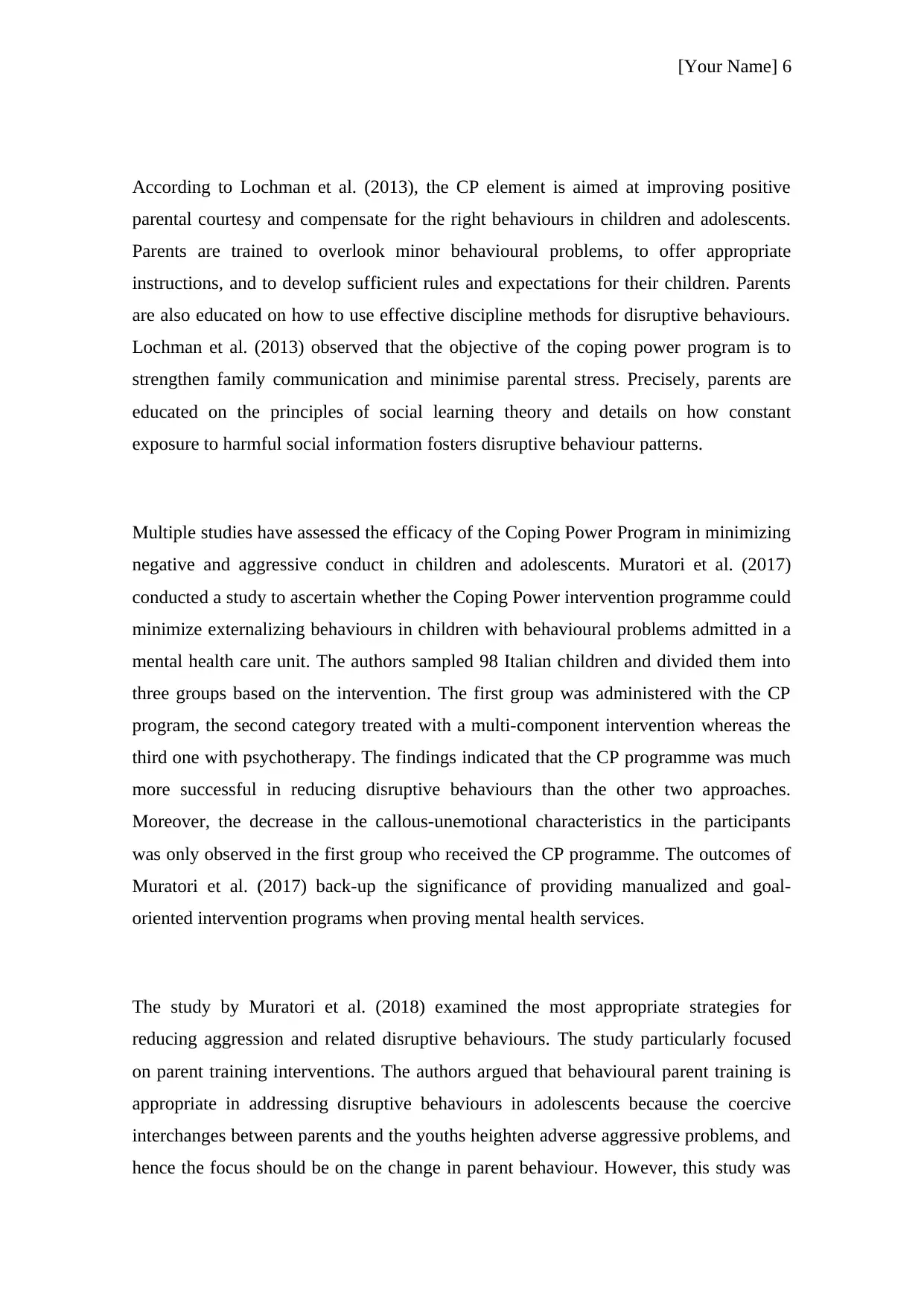
[Your Name] 6
According to Lochman et al. (2013), the CP element is aimed at improving positive
parental courtesy and compensate for the right behaviours in children and adolescents.
Parents are trained to overlook minor behavioural problems, to offer appropriate
instructions, and to develop sufficient rules and expectations for their children. Parents
are also educated on how to use effective discipline methods for disruptive behaviours.
Lochman et al. (2013) observed that the objective of the coping power program is to
strengthen family communication and minimise parental stress. Precisely, parents are
educated on the principles of social learning theory and details on how constant
exposure to harmful social information fosters disruptive behaviour patterns.
Multiple studies have assessed the efficacy of the Coping Power Program in minimizing
negative and aggressive conduct in children and adolescents. Muratori et al. (2017)
conducted a study to ascertain whether the Coping Power intervention programme could
minimize externalizing behaviours in children with behavioural problems admitted in a
mental health care unit. The authors sampled 98 Italian children and divided them into
three groups based on the intervention. The first group was administered with the CP
program, the second category treated with a multi-component intervention whereas the
third one with psychotherapy. The findings indicated that the CP programme was much
more successful in reducing disruptive behaviours than the other two approaches.
Moreover, the decrease in the callous-unemotional characteristics in the participants
was only observed in the first group who received the CP programme. The outcomes of
Muratori et al. (2017) back-up the significance of providing manualized and goal-
oriented intervention programs when proving mental health services.
The study by Muratori et al. (2018) examined the most appropriate strategies for
reducing aggression and related disruptive behaviours. The study particularly focused
on parent training interventions. The authors argued that behavioural parent training is
appropriate in addressing disruptive behaviours in adolescents because the coercive
interchanges between parents and the youths heighten adverse aggressive problems, and
hence the focus should be on the change in parent behaviour. However, this study was
According to Lochman et al. (2013), the CP element is aimed at improving positive
parental courtesy and compensate for the right behaviours in children and adolescents.
Parents are trained to overlook minor behavioural problems, to offer appropriate
instructions, and to develop sufficient rules and expectations for their children. Parents
are also educated on how to use effective discipline methods for disruptive behaviours.
Lochman et al. (2013) observed that the objective of the coping power program is to
strengthen family communication and minimise parental stress. Precisely, parents are
educated on the principles of social learning theory and details on how constant
exposure to harmful social information fosters disruptive behaviour patterns.
Multiple studies have assessed the efficacy of the Coping Power Program in minimizing
negative and aggressive conduct in children and adolescents. Muratori et al. (2017)
conducted a study to ascertain whether the Coping Power intervention programme could
minimize externalizing behaviours in children with behavioural problems admitted in a
mental health care unit. The authors sampled 98 Italian children and divided them into
three groups based on the intervention. The first group was administered with the CP
program, the second category treated with a multi-component intervention whereas the
third one with psychotherapy. The findings indicated that the CP programme was much
more successful in reducing disruptive behaviours than the other two approaches.
Moreover, the decrease in the callous-unemotional characteristics in the participants
was only observed in the first group who received the CP programme. The outcomes of
Muratori et al. (2017) back-up the significance of providing manualized and goal-
oriented intervention programs when proving mental health services.
The study by Muratori et al. (2018) examined the most appropriate strategies for
reducing aggression and related disruptive behaviours. The study particularly focused
on parent training interventions. The authors argued that behavioural parent training is
appropriate in addressing disruptive behaviours in adolescents because the coercive
interchanges between parents and the youths heighten adverse aggressive problems, and
hence the focus should be on the change in parent behaviour. However, this study was
⊘ This is a preview!⊘
Do you want full access?
Subscribe today to unlock all pages.

Trusted by 1+ million students worldwide
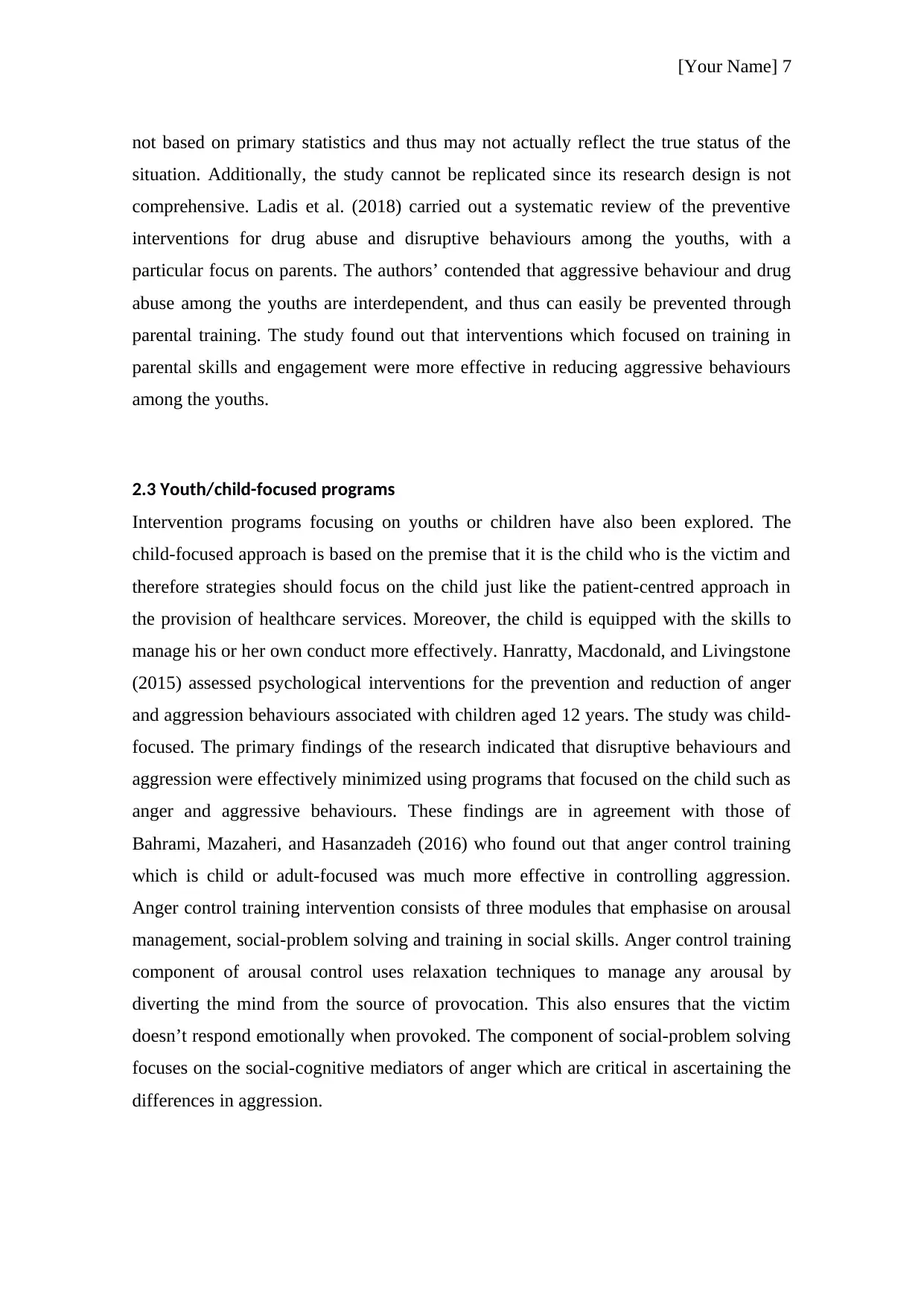
[Your Name] 7
not based on primary statistics and thus may not actually reflect the true status of the
situation. Additionally, the study cannot be replicated since its research design is not
comprehensive. Ladis et al. (2018) carried out a systematic review of the preventive
interventions for drug abuse and disruptive behaviours among the youths, with a
particular focus on parents. The authors’ contended that aggressive behaviour and drug
abuse among the youths are interdependent, and thus can easily be prevented through
parental training. The study found out that interventions which focused on training in
parental skills and engagement were more effective in reducing aggressive behaviours
among the youths.
2.3 Youth/child-focused programs
Intervention programs focusing on youths or children have also been explored. The
child-focused approach is based on the premise that it is the child who is the victim and
therefore strategies should focus on the child just like the patient-centred approach in
the provision of healthcare services. Moreover, the child is equipped with the skills to
manage his or her own conduct more effectively. Hanratty, Macdonald, and Livingstone
(2015) assessed psychological interventions for the prevention and reduction of anger
and aggression behaviours associated with children aged 12 years. The study was child-
focused. The primary findings of the research indicated that disruptive behaviours and
aggression were effectively minimized using programs that focused on the child such as
anger and aggressive behaviours. These findings are in agreement with those of
Bahrami, Mazaheri, and Hasanzadeh (2016) who found out that anger control training
which is child or adult-focused was much more effective in controlling aggression.
Anger control training intervention consists of three modules that emphasise on arousal
management, social-problem solving and training in social skills. Anger control training
component of arousal control uses relaxation techniques to manage any arousal by
diverting the mind from the source of provocation. This also ensures that the victim
doesn’t respond emotionally when provoked. The component of social-problem solving
focuses on the social-cognitive mediators of anger which are critical in ascertaining the
differences in aggression.
not based on primary statistics and thus may not actually reflect the true status of the
situation. Additionally, the study cannot be replicated since its research design is not
comprehensive. Ladis et al. (2018) carried out a systematic review of the preventive
interventions for drug abuse and disruptive behaviours among the youths, with a
particular focus on parents. The authors’ contended that aggressive behaviour and drug
abuse among the youths are interdependent, and thus can easily be prevented through
parental training. The study found out that interventions which focused on training in
parental skills and engagement were more effective in reducing aggressive behaviours
among the youths.
2.3 Youth/child-focused programs
Intervention programs focusing on youths or children have also been explored. The
child-focused approach is based on the premise that it is the child who is the victim and
therefore strategies should focus on the child just like the patient-centred approach in
the provision of healthcare services. Moreover, the child is equipped with the skills to
manage his or her own conduct more effectively. Hanratty, Macdonald, and Livingstone
(2015) assessed psychological interventions for the prevention and reduction of anger
and aggression behaviours associated with children aged 12 years. The study was child-
focused. The primary findings of the research indicated that disruptive behaviours and
aggression were effectively minimized using programs that focused on the child such as
anger and aggressive behaviours. These findings are in agreement with those of
Bahrami, Mazaheri, and Hasanzadeh (2016) who found out that anger control training
which is child or adult-focused was much more effective in controlling aggression.
Anger control training intervention consists of three modules that emphasise on arousal
management, social-problem solving and training in social skills. Anger control training
component of arousal control uses relaxation techniques to manage any arousal by
diverting the mind from the source of provocation. This also ensures that the victim
doesn’t respond emotionally when provoked. The component of social-problem solving
focuses on the social-cognitive mediators of anger which are critical in ascertaining the
differences in aggression.
Paraphrase This Document
Need a fresh take? Get an instant paraphrase of this document with our AI Paraphraser
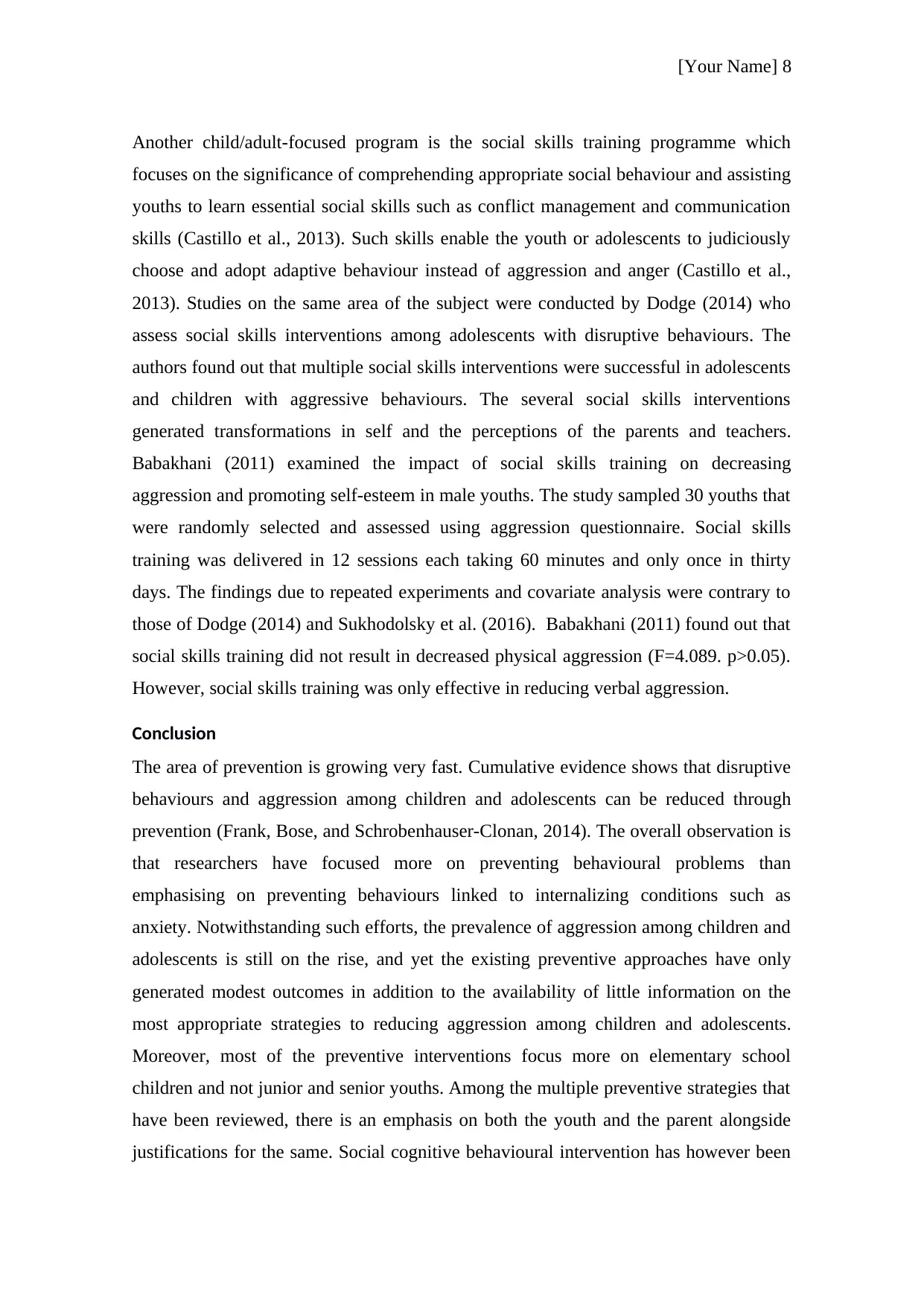
[Your Name] 8
Another child/adult-focused program is the social skills training programme which
focuses on the significance of comprehending appropriate social behaviour and assisting
youths to learn essential social skills such as conflict management and communication
skills (Castillo et al., 2013). Such skills enable the youth or adolescents to judiciously
choose and adopt adaptive behaviour instead of aggression and anger (Castillo et al.,
2013). Studies on the same area of the subject were conducted by Dodge (2014) who
assess social skills interventions among adolescents with disruptive behaviours. The
authors found out that multiple social skills interventions were successful in adolescents
and children with aggressive behaviours. The several social skills interventions
generated transformations in self and the perceptions of the parents and teachers.
Babakhani (2011) examined the impact of social skills training on decreasing
aggression and promoting self-esteem in male youths. The study sampled 30 youths that
were randomly selected and assessed using aggression questionnaire. Social skills
training was delivered in 12 sessions each taking 60 minutes and only once in thirty
days. The findings due to repeated experiments and covariate analysis were contrary to
those of Dodge (2014) and Sukhodolsky et al. (2016). Babakhani (2011) found out that
social skills training did not result in decreased physical aggression (F=4.089. p>0.05).
However, social skills training was only effective in reducing verbal aggression.
Conclusion
The area of prevention is growing very fast. Cumulative evidence shows that disruptive
behaviours and aggression among children and adolescents can be reduced through
prevention (Frank, Bose, and Schrobenhauser-Clonan, 2014). The overall observation is
that researchers have focused more on preventing behavioural problems than
emphasising on preventing behaviours linked to internalizing conditions such as
anxiety. Notwithstanding such efforts, the prevalence of aggression among children and
adolescents is still on the rise, and yet the existing preventive approaches have only
generated modest outcomes in addition to the availability of little information on the
most appropriate strategies to reducing aggression among children and adolescents.
Moreover, most of the preventive interventions focus more on elementary school
children and not junior and senior youths. Among the multiple preventive strategies that
have been reviewed, there is an emphasis on both the youth and the parent alongside
justifications for the same. Social cognitive behavioural intervention has however been
Another child/adult-focused program is the social skills training programme which
focuses on the significance of comprehending appropriate social behaviour and assisting
youths to learn essential social skills such as conflict management and communication
skills (Castillo et al., 2013). Such skills enable the youth or adolescents to judiciously
choose and adopt adaptive behaviour instead of aggression and anger (Castillo et al.,
2013). Studies on the same area of the subject were conducted by Dodge (2014) who
assess social skills interventions among adolescents with disruptive behaviours. The
authors found out that multiple social skills interventions were successful in adolescents
and children with aggressive behaviours. The several social skills interventions
generated transformations in self and the perceptions of the parents and teachers.
Babakhani (2011) examined the impact of social skills training on decreasing
aggression and promoting self-esteem in male youths. The study sampled 30 youths that
were randomly selected and assessed using aggression questionnaire. Social skills
training was delivered in 12 sessions each taking 60 minutes and only once in thirty
days. The findings due to repeated experiments and covariate analysis were contrary to
those of Dodge (2014) and Sukhodolsky et al. (2016). Babakhani (2011) found out that
social skills training did not result in decreased physical aggression (F=4.089. p>0.05).
However, social skills training was only effective in reducing verbal aggression.
Conclusion
The area of prevention is growing very fast. Cumulative evidence shows that disruptive
behaviours and aggression among children and adolescents can be reduced through
prevention (Frank, Bose, and Schrobenhauser-Clonan, 2014). The overall observation is
that researchers have focused more on preventing behavioural problems than
emphasising on preventing behaviours linked to internalizing conditions such as
anxiety. Notwithstanding such efforts, the prevalence of aggression among children and
adolescents is still on the rise, and yet the existing preventive approaches have only
generated modest outcomes in addition to the availability of little information on the
most appropriate strategies to reducing aggression among children and adolescents.
Moreover, most of the preventive interventions focus more on elementary school
children and not junior and senior youths. Among the multiple preventive strategies that
have been reviewed, there is an emphasis on both the youth and the parent alongside
justifications for the same. Social cognitive behavioural intervention has however been
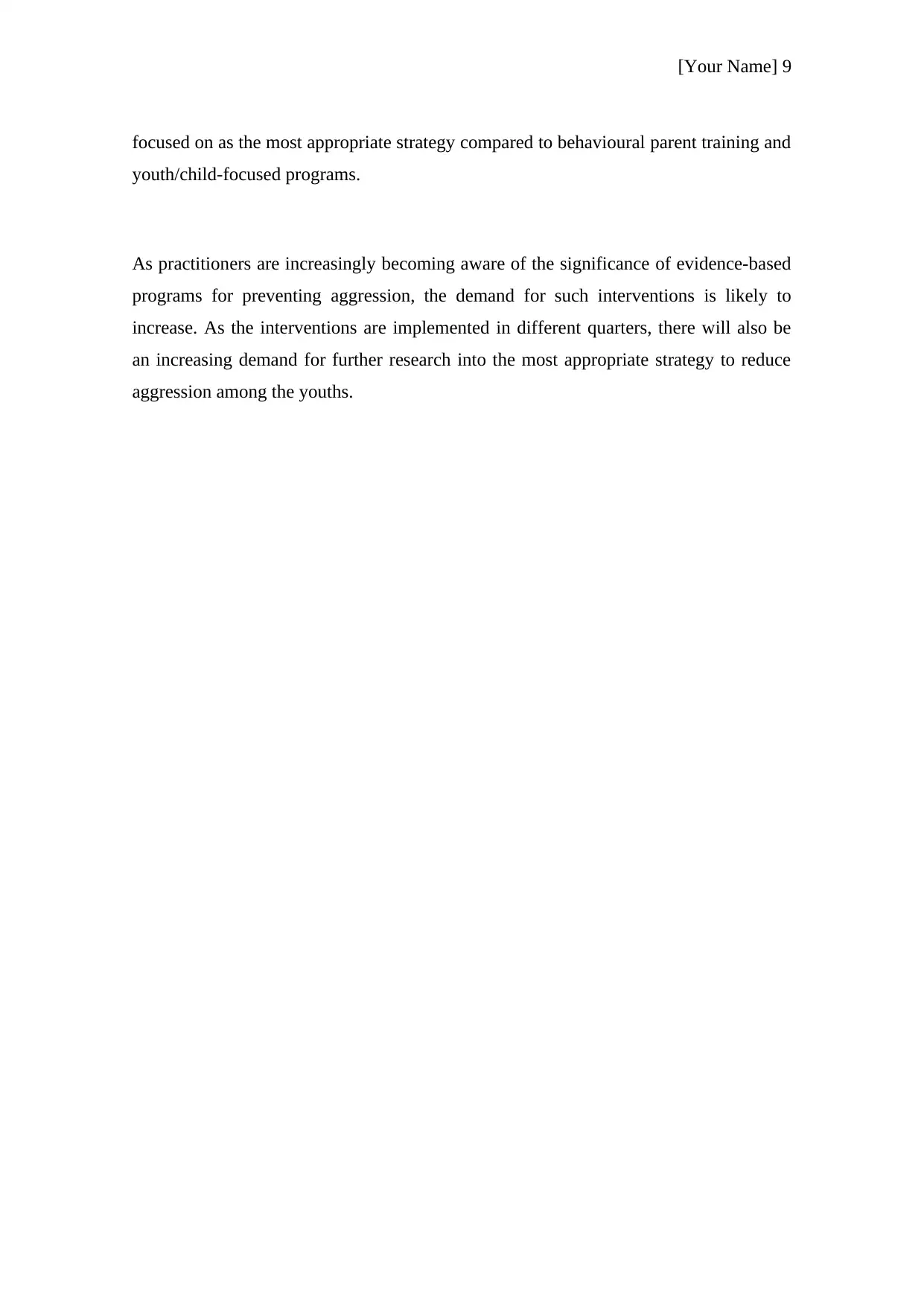
[Your Name] 9
focused on as the most appropriate strategy compared to behavioural parent training and
youth/child-focused programs.
As practitioners are increasingly becoming aware of the significance of evidence-based
programs for preventing aggression, the demand for such interventions is likely to
increase. As the interventions are implemented in different quarters, there will also be
an increasing demand for further research into the most appropriate strategy to reduce
aggression among the youths.
focused on as the most appropriate strategy compared to behavioural parent training and
youth/child-focused programs.
As practitioners are increasingly becoming aware of the significance of evidence-based
programs for preventing aggression, the demand for such interventions is likely to
increase. As the interventions are implemented in different quarters, there will also be
an increasing demand for further research into the most appropriate strategy to reduce
aggression among the youths.
⊘ This is a preview!⊘
Do you want full access?
Subscribe today to unlock all pages.

Trusted by 1+ million students worldwide
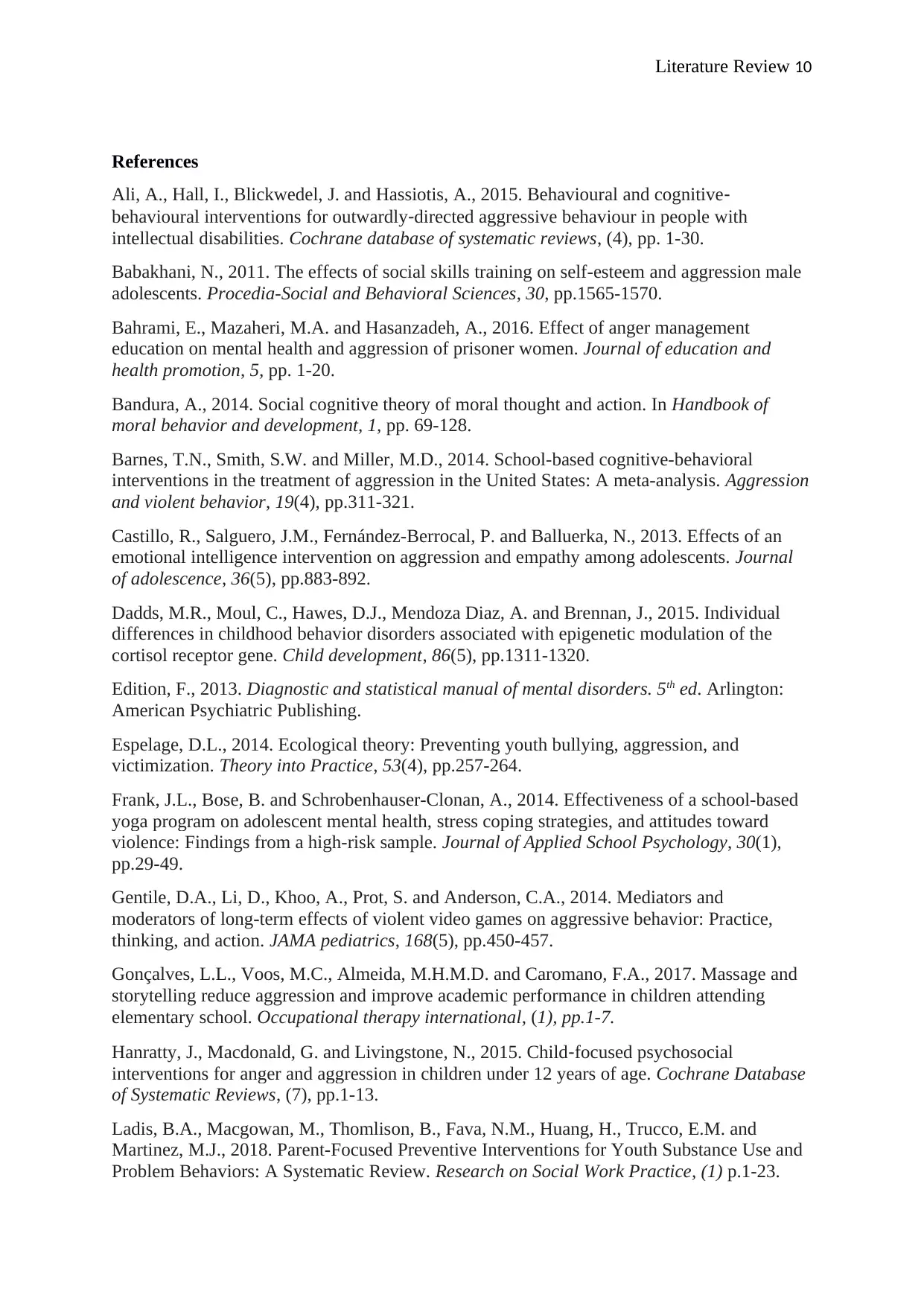
Literature Review 10
References
Ali, A., Hall, I., Blickwedel, J. and Hassiotis, A., 2015. Behavioural and cognitive‐
behavioural interventions for outwardly‐directed aggressive behaviour in people with
intellectual disabilities. Cochrane database of systematic reviews, (4), pp. 1-30.
Babakhani, N., 2011. The effects of social skills training on self-esteem and aggression male
adolescents. Procedia-Social and Behavioral Sciences, 30, pp.1565-1570.
Bahrami, E., Mazaheri, M.A. and Hasanzadeh, A., 2016. Effect of anger management
education on mental health and aggression of prisoner women. Journal of education and
health promotion, 5, pp. 1-20.
Bandura, A., 2014. Social cognitive theory of moral thought and action. In Handbook of
moral behavior and development, 1, pp. 69-128.
Barnes, T.N., Smith, S.W. and Miller, M.D., 2014. School-based cognitive-behavioral
interventions in the treatment of aggression in the United States: A meta-analysis. Aggression
and violent behavior, 19(4), pp.311-321.
Castillo, R., Salguero, J.M., Fernández-Berrocal, P. and Balluerka, N., 2013. Effects of an
emotional intelligence intervention on aggression and empathy among adolescents. Journal
of adolescence, 36(5), pp.883-892.
Dadds, M.R., Moul, C., Hawes, D.J., Mendoza Diaz, A. and Brennan, J., 2015. Individual
differences in childhood behavior disorders associated with epigenetic modulation of the
cortisol receptor gene. Child development, 86(5), pp.1311-1320.
Edition, F., 2013. Diagnostic and statistical manual of mental disorders. 5th ed. Arlington:
American Psychiatric Publishing.
Espelage, D.L., 2014. Ecological theory: Preventing youth bullying, aggression, and
victimization. Theory into Practice, 53(4), pp.257-264.
Frank, J.L., Bose, B. and Schrobenhauser-Clonan, A., 2014. Effectiveness of a school-based
yoga program on adolescent mental health, stress coping strategies, and attitudes toward
violence: Findings from a high-risk sample. Journal of Applied School Psychology, 30(1),
pp.29-49.
Gentile, D.A., Li, D., Khoo, A., Prot, S. and Anderson, C.A., 2014. Mediators and
moderators of long-term effects of violent video games on aggressive behavior: Practice,
thinking, and action. JAMA pediatrics, 168(5), pp.450-457.
Gonçalves, L.L., Voos, M.C., Almeida, M.H.M.D. and Caromano, F.A., 2017. Massage and
storytelling reduce aggression and improve academic performance in children attending
elementary school. Occupational therapy international, (1), pp.1-7.
Hanratty, J., Macdonald, G. and Livingstone, N., 2015. Child‐focused psychosocial
interventions for anger and aggression in children under 12 years of age. Cochrane Database
of Systematic Reviews, (7), pp.1-13.
Ladis, B.A., Macgowan, M., Thomlison, B., Fava, N.M., Huang, H., Trucco, E.M. and
Martinez, M.J., 2018. Parent-Focused Preventive Interventions for Youth Substance Use and
Problem Behaviors: A Systematic Review. Research on Social Work Practice, (1) p.1-23.
References
Ali, A., Hall, I., Blickwedel, J. and Hassiotis, A., 2015. Behavioural and cognitive‐
behavioural interventions for outwardly‐directed aggressive behaviour in people with
intellectual disabilities. Cochrane database of systematic reviews, (4), pp. 1-30.
Babakhani, N., 2011. The effects of social skills training on self-esteem and aggression male
adolescents. Procedia-Social and Behavioral Sciences, 30, pp.1565-1570.
Bahrami, E., Mazaheri, M.A. and Hasanzadeh, A., 2016. Effect of anger management
education on mental health and aggression of prisoner women. Journal of education and
health promotion, 5, pp. 1-20.
Bandura, A., 2014. Social cognitive theory of moral thought and action. In Handbook of
moral behavior and development, 1, pp. 69-128.
Barnes, T.N., Smith, S.W. and Miller, M.D., 2014. School-based cognitive-behavioral
interventions in the treatment of aggression in the United States: A meta-analysis. Aggression
and violent behavior, 19(4), pp.311-321.
Castillo, R., Salguero, J.M., Fernández-Berrocal, P. and Balluerka, N., 2013. Effects of an
emotional intelligence intervention on aggression and empathy among adolescents. Journal
of adolescence, 36(5), pp.883-892.
Dadds, M.R., Moul, C., Hawes, D.J., Mendoza Diaz, A. and Brennan, J., 2015. Individual
differences in childhood behavior disorders associated with epigenetic modulation of the
cortisol receptor gene. Child development, 86(5), pp.1311-1320.
Edition, F., 2013. Diagnostic and statistical manual of mental disorders. 5th ed. Arlington:
American Psychiatric Publishing.
Espelage, D.L., 2014. Ecological theory: Preventing youth bullying, aggression, and
victimization. Theory into Practice, 53(4), pp.257-264.
Frank, J.L., Bose, B. and Schrobenhauser-Clonan, A., 2014. Effectiveness of a school-based
yoga program on adolescent mental health, stress coping strategies, and attitudes toward
violence: Findings from a high-risk sample. Journal of Applied School Psychology, 30(1),
pp.29-49.
Gentile, D.A., Li, D., Khoo, A., Prot, S. and Anderson, C.A., 2014. Mediators and
moderators of long-term effects of violent video games on aggressive behavior: Practice,
thinking, and action. JAMA pediatrics, 168(5), pp.450-457.
Gonçalves, L.L., Voos, M.C., Almeida, M.H.M.D. and Caromano, F.A., 2017. Massage and
storytelling reduce aggression and improve academic performance in children attending
elementary school. Occupational therapy international, (1), pp.1-7.
Hanratty, J., Macdonald, G. and Livingstone, N., 2015. Child‐focused psychosocial
interventions for anger and aggression in children under 12 years of age. Cochrane Database
of Systematic Reviews, (7), pp.1-13.
Ladis, B.A., Macgowan, M., Thomlison, B., Fava, N.M., Huang, H., Trucco, E.M. and
Martinez, M.J., 2018. Parent-Focused Preventive Interventions for Youth Substance Use and
Problem Behaviors: A Systematic Review. Research on Social Work Practice, (1) p.1-23.
Paraphrase This Document
Need a fresh take? Get an instant paraphrase of this document with our AI Paraphraser
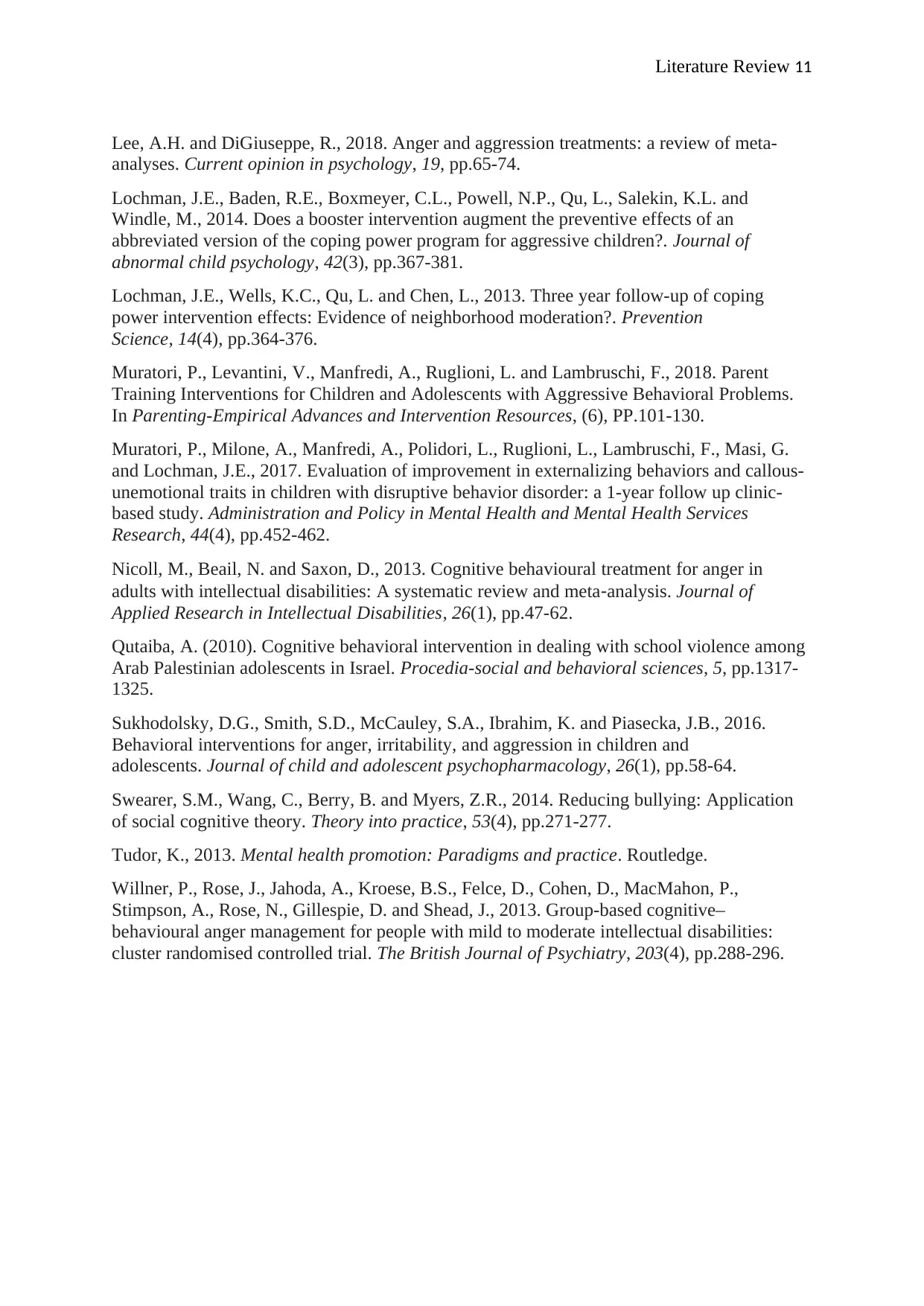
Literature Review 11
Lee, A.H. and DiGiuseppe, R., 2018. Anger and aggression treatments: a review of meta-
analyses. Current opinion in psychology, 19, pp.65-74.
Lochman, J.E., Baden, R.E., Boxmeyer, C.L., Powell, N.P., Qu, L., Salekin, K.L. and
Windle, M., 2014. Does a booster intervention augment the preventive effects of an
abbreviated version of the coping power program for aggressive children?. Journal of
abnormal child psychology, 42(3), pp.367-381.
Lochman, J.E., Wells, K.C., Qu, L. and Chen, L., 2013. Three year follow-up of coping
power intervention effects: Evidence of neighborhood moderation?. Prevention
Science, 14(4), pp.364-376.
Muratori, P., Levantini, V., Manfredi, A., Ruglioni, L. and Lambruschi, F., 2018. Parent
Training Interventions for Children and Adolescents with Aggressive Behavioral Problems.
In Parenting-Empirical Advances and Intervention Resources, (6), PP.101-130.
Muratori, P., Milone, A., Manfredi, A., Polidori, L., Ruglioni, L., Lambruschi, F., Masi, G.
and Lochman, J.E., 2017. Evaluation of improvement in externalizing behaviors and callous-
unemotional traits in children with disruptive behavior disorder: a 1-year follow up clinic-
based study. Administration and Policy in Mental Health and Mental Health Services
Research, 44(4), pp.452-462.
Nicoll, M., Beail, N. and Saxon, D., 2013. Cognitive behavioural treatment for anger in
adults with intellectual disabilities: A systematic review and meta‐analysis. Journal of
Applied Research in Intellectual Disabilities, 26(1), pp.47-62.
Qutaiba, A. (2010). Cognitive behavioral intervention in dealing with school violence among
Arab Palestinian adolescents in Israel. Procedia-social and behavioral sciences, 5, pp.1317-
1325.
Sukhodolsky, D.G., Smith, S.D., McCauley, S.A., Ibrahim, K. and Piasecka, J.B., 2016.
Behavioral interventions for anger, irritability, and aggression in children and
adolescents. Journal of child and adolescent psychopharmacology, 26(1), pp.58-64.
Swearer, S.M., Wang, C., Berry, B. and Myers, Z.R., 2014. Reducing bullying: Application
of social cognitive theory. Theory into practice, 53(4), pp.271-277.
Tudor, K., 2013. Mental health promotion: Paradigms and practice. Routledge.
Willner, P., Rose, J., Jahoda, A., Kroese, B.S., Felce, D., Cohen, D., MacMahon, P.,
Stimpson, A., Rose, N., Gillespie, D. and Shead, J., 2013. Group-based cognitive–
behavioural anger management for people with mild to moderate intellectual disabilities:
cluster randomised controlled trial. The British Journal of Psychiatry, 203(4), pp.288-296.
Lee, A.H. and DiGiuseppe, R., 2018. Anger and aggression treatments: a review of meta-
analyses. Current opinion in psychology, 19, pp.65-74.
Lochman, J.E., Baden, R.E., Boxmeyer, C.L., Powell, N.P., Qu, L., Salekin, K.L. and
Windle, M., 2014. Does a booster intervention augment the preventive effects of an
abbreviated version of the coping power program for aggressive children?. Journal of
abnormal child psychology, 42(3), pp.367-381.
Lochman, J.E., Wells, K.C., Qu, L. and Chen, L., 2013. Three year follow-up of coping
power intervention effects: Evidence of neighborhood moderation?. Prevention
Science, 14(4), pp.364-376.
Muratori, P., Levantini, V., Manfredi, A., Ruglioni, L. and Lambruschi, F., 2018. Parent
Training Interventions for Children and Adolescents with Aggressive Behavioral Problems.
In Parenting-Empirical Advances and Intervention Resources, (6), PP.101-130.
Muratori, P., Milone, A., Manfredi, A., Polidori, L., Ruglioni, L., Lambruschi, F., Masi, G.
and Lochman, J.E., 2017. Evaluation of improvement in externalizing behaviors and callous-
unemotional traits in children with disruptive behavior disorder: a 1-year follow up clinic-
based study. Administration and Policy in Mental Health and Mental Health Services
Research, 44(4), pp.452-462.
Nicoll, M., Beail, N. and Saxon, D., 2013. Cognitive behavioural treatment for anger in
adults with intellectual disabilities: A systematic review and meta‐analysis. Journal of
Applied Research in Intellectual Disabilities, 26(1), pp.47-62.
Qutaiba, A. (2010). Cognitive behavioral intervention in dealing with school violence among
Arab Palestinian adolescents in Israel. Procedia-social and behavioral sciences, 5, pp.1317-
1325.
Sukhodolsky, D.G., Smith, S.D., McCauley, S.A., Ibrahim, K. and Piasecka, J.B., 2016.
Behavioral interventions for anger, irritability, and aggression in children and
adolescents. Journal of child and adolescent psychopharmacology, 26(1), pp.58-64.
Swearer, S.M., Wang, C., Berry, B. and Myers, Z.R., 2014. Reducing bullying: Application
of social cognitive theory. Theory into practice, 53(4), pp.271-277.
Tudor, K., 2013. Mental health promotion: Paradigms and practice. Routledge.
Willner, P., Rose, J., Jahoda, A., Kroese, B.S., Felce, D., Cohen, D., MacMahon, P.,
Stimpson, A., Rose, N., Gillespie, D. and Shead, J., 2013. Group-based cognitive–
behavioural anger management for people with mild to moderate intellectual disabilities:
cluster randomised controlled trial. The British Journal of Psychiatry, 203(4), pp.288-296.
1 out of 11
Related Documents
Your All-in-One AI-Powered Toolkit for Academic Success.
+13062052269
info@desklib.com
Available 24*7 on WhatsApp / Email
![[object Object]](/_next/static/media/star-bottom.7253800d.svg)
Unlock your academic potential
Copyright © 2020–2025 A2Z Services. All Rights Reserved. Developed and managed by ZUCOL.




